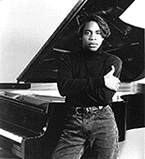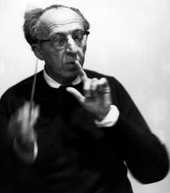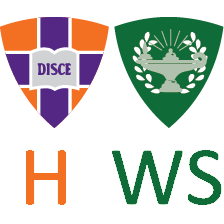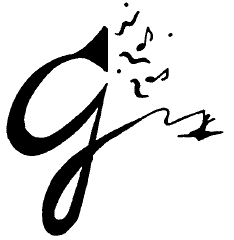Geneva Concerts Presents:
Thursday, 7 March 2002, 8:15 PM
Syracuse Symphony Orchestra
Daniel Hege, Music Director
American Music of the
Twentieth Century

Leonard Bernstein and Aaron Copland in 1945 at Barnegat, New Jersey,
singing "I Ride an Old Paint," a tune similar to one Copland used
in his Third Symphony.
Terrence Wilson, Piano
The Program
Overture: Candide
BERNSTEIN: Overture from Candide
LARSEN: Concert Overture: Parachute Dancing
GERSHWIN: Rhapsody In Blue
Intermission
COPLAND: Symphony No. 3
Program Notes

Daniel Hege
Music Director
Now in his second season as Music Director of the Syracuse Symphony
Orchestra, Daniel Hege is widely regarded as one of America's finest
young conductors. He has earned critical acclaim for his fresh
interpretations of standard repertoire and is recognized for his
commitment to creative programming.
Mr. Hege has held several notable positions, including Music Director of
the Young Musicians Foundation Debut Orchestra in Los Angeles, Assistant
Conductor of the Pacific Symphony Orchestra, and Principal Conductor of
Disney's Young Musicians Symphony Orchestra. Concerts with the latter
were televised nationally by the Disney Channel to more than 50 million
viewers. Mr. Hege has also served as Music Director of the Haddonfield
Symphony (New Jersey), Associate Conductor of the Kansas City Symphony,
Music Director of the Encore Chamber Orchestra of Chicago and Music
Director of the Chicago Youth Symphony Orchestra.
In addition to his duties as SSO Music Director, Mr. Hege is Resident
Conductor of the Baltimore Symphony Orchestra. He was asked to step in
for an ailing David Zinman during the BSO's 1997 Japan Tour and led that
in a climactic final concert in Tokyo's famed Suntory Hall.
Mr. Hege has led the San Antonio Symphony, the Louisville Orchestra, the
Houston Symphony, the Louisiana Philharmonic Orchestra, the Los Angeles
Mozart Orchestra, Florida's Naples Philharmonic Orchestra, and the
Auckland Philharmonic in New Zealand. This past summer, he appeared once
again at the Aspen Music Festival. Coming guest conducting engagements
include debuts with the Seattle, Oregon and Colorado symphonies. His
recordings include the recently released Syracuse Symphony Orchestra CD,
a disc with violinist Rachel Barton and the Encore Chamber Orchestra of
Chicago on Cedille Records, and a recording with the Baltimore Symphony
Orchestra and the Morgan State University Choir of the works of
contemporary African-American composer Adolphus Hailstork.
A graduate of Bethel College with a bachelor's degree in music and
history, he earned his master of music degree in orchestral conducting
from the University of Utah. Mr. Hege subsequently studied with Paul
Vermel at the Aspen Music Festival and with noted conductor Daniel Lewis
of the University of Southern California.
Born in Colorado and raised in Idaho, Mr. Hege resides in Jamesville
with his wife, violinist Katarina Oladottir Hege, and their daughter Arianna.

Terrence Wilson
Piano
In the short time since his professional debut with the Philadelphia
Orchestra, tonight's guest artist has already appeared with the
Cleveland
Orchestra at the Blossom Festival, the Atlanta, Cincinnati, Dallas,
Detroit, Saint Louis, Baltimore, Indianapolis, San Francisco and
Colorado
symphony orchestras and the Minnesota Orchestra. He also made acclaimed
recital debuts at the 92nd Street Y in New York, and in Washington at
the Kennedy Center.
Recently, Mr. Wilson has appeared at the Mann Music Center with the
Philadelphia Orchestra and at Wolf Trap with the National Symphony
Orchestra. He has been a guest soloist with the Austin Symphony, the
Buffalo Philharmonic, the Florida Orchestra and the Naples Philharmonic,
as well as the Riverbend Festival with the Cincinnati Symphony.
Recital appearances have taken Mr. Wilson to Chicago's Ravinia series,
the La Jolla Chamber Music Society in San Diego, the Herbst Theatre in
San Francisco, the University of Massachusetts and Caramoor in Katonah,
New York. In 1995, he gave a pre-concert recital at the Mostly Mozart
Festival in Avery Fisher Hall.
Born in the Bronx in 1975, Mr. Wilson began piano lessons at age 9, and
at age 11 won a Brooklyn Arts and Culture Appreciation Competition. He
began studies with his current teacher, Yoheved Kaplinsky, in 1989, and
the same year entered the Preparatory Division of the Manhattan School
of Music and the Professional Children's School. He is currently a
scholarship student at the Juilliard School, where he received the
prestigious Sony ES Award for Musical Excellence.
Read more about Terrence Wilson in the article
Dialing In
from the Syracuse Herald American.
Leonard Bernstein
Born: Lawrence, MA August 25, 1918.
Died: New York, October 14, 1990.
Overture from Candide
Composed: 1956.
Premiere: New York's Martin Beck Theater, December 1, 1956.
Dr. Pangloss' philosophy that "all is for the best in the best of all
possible worlds" received sophisticated operatic treatment from
Bersntein
and librettist Lillian Hellman when their adaptation of Candide,
Voltaire's satirical view of 18th-century Europe, appeared on the stage
in the early 1950s. Yet it proved to be a little too sophisticated for
Broadway audiences, and although Bernstein's music gained critical
acclaim the musical disappeared before long.
About that time Bernstein had been discussing on the radio his views on
the differences between European operetta and American musical comedy,
and it seemed that he agonized somewhat over this matter while composing
the music for Candide. The final product turned out to be an essay more
on the European operetta style, and this perhaps was why Broadway
audiences felt a little cheated. They had been used to the Bernstein of
Fancy Free and On the Town, and they were soon to get an even more
substantial dose later in the decade with his powerful score for West
Side Story.
With a revised book from Hugh Wheeler, a few new lyrics from Stephen
Sondheim and an orchestra reduced in size, Bernstein's score for Candide
was successfully revived in 1973, and since then it has been performed
by
numerous companies, professional and amateur, throughout the country.
The
overall effect of the revisions was to make Candide more a musical, less
an operetta - and it seems to have worked in terms of popularity, though
many sophisticates still prefer the older Hellman book.
The Overture, utilizing tunes from the musical, bubbles with energy and
life right from the start, its vigorous opening themes balanced by a
later more lyrical melody. The tunes recur, eventually to be capped by a
bright, strutting coda notable for its strong rhythmic impulse and
melodic charm.
Throughout the Overture, as later in the musical, Bernstein seems to be
having fun parodying European operetta and comic-opera styles (from
Rossini to Sullivan). But the Overture's exuberance also presages the
composer's lighthearted approach to the dire happenings that will soon
separate Candide from his beloved Cunegonde and cause disillusion to set
in.
Maybe such a musical shrug of the shoulders is the best way of dealing
with Voltaire's essentially pessimistic view of the 18th-century social
order. This is music that might well please the disenchanted Candide as
he retreats from the world to attend to his garden.
Instrumentation consists of two flutes and piccolo, two oboes, two
clarinets, bass clarinet, e-flat clarinet, two bassoons and
contrabassoon, four horns, two trumpets, three trombones, tuba, timpani,
bass drum, glockenspiel, cymbals, xylophone, triangle, snare drum, tenor
drum, harp and strings.

Libby Larsen
Born: Wilmington, DE, Dec. 24, 1950.
Concert Overture: Parachute Dancing
Composed: 1983.
Premiere: 1983, American Composers Orchestra, conducted by Thomas Nee.
Composer in residence with the Minnesota Orchestra from 1983 to 1987,
Libby Larsen has written for orchestral, vocal and chamber ensembles, as
well as the stage. Her stage works include her doctoral thesis, The
Words
upon the Windowpane (1978); The Silver Fox for children (1979);
Tumbledown Dick (1980); a romantic fantasy, Clair de lune (1984); a
chamber opera, Christina Romana; the musical drama Frankenstein, or The
Modern Prometheus (1990); and A Wrinkle in Time (1992) for Opera
Delaware (her home state).
Her more recent Ghosts of an Old Ceremony involves a strong visual
dimension, utilizing both video and dance, and illustrates her interest
in working with both acoustic and electronic sound.
In the orchestral sphere, she has composed several symphonies, the third
(entitled The Lyric) being premiered during the 1991-92 season with the
Albany Symphony; a Piano Concerto, also premiered during the 1991-92
season (this time with the Minnesota Orchestra and Janina Fialkowski as
soloist); and since then a Marimba Concerto: after [Lionel] Hampton.
Like the Marimba Concerto, the Overture: Parachute Jumping,
commissioned
by the American Composers Orchestra, utilizes a considerable battery of
percussion instruments. They are all used with delicacy, however,
creating a chamber effect. This is entirely in keeping with the mood of
the Overture, which is light and rhythmically animated.
On the front page of her score, Larsen provides a brief explanation of
the idea which inspired the piece: "During the Renaissance there was a
spectacular court dance involving parachutes. Dancers would climb atop
courtyard walls carrying enormous brightly colored silk umbrellas.
They'd
begin dancing short hopping steps which became raucous leaps along their
precarious ledge until suddenly, they would hurtle themselves off the
wall overhead, and float down into the midst of the spectators."
Appropriately enough, at first Larsen uses her instrumental forces
sparingly, the percussion creating the light rhythmic impetus. Brief
motifs are heard on piano, brass, woodwinds, and then strings, all
brisk;
for example, a staccato seven-note motif on piano and brass, which
recurs
later on in the piece. By then, however, Larsen has stepped up the
orchestral excitement, which becomes even more frenetic toward the end,
with Larsen calling upon her flutists and clarinetists to stand up, the
horn players to raise their bells and the trombonists their slides, in
readiness for the moment when the renaissance court parachutists make
their leap. At the crucial moment, when they are about to jump, there is
a pause in the orchestra as the horns lower their bells, the trombones
their slides, with the strings finally suggesting the parachutists'
descent, and the cellos and double basses offering a final glissando or
downward slide, the quiet pizzicato conclusion suggesting that all have
landed gently and safely.
The orchestra is the normal-sized one for post-Beethovenian symphonic
music, save for the large percussion section which is arranged in three
groups:
- Suspended cymbal, tambourine, slapstick, marimba, crash
cymbals.
- Finger cymbals, xylophone, crash cymbals.
- Bass drum, 3 tom-toms, orchestra bells, cymbals.
This work is scored for two flutes, two oboes, two clarinets, two
bassoons, four horns, two trumpets, three trombones, tuba, timpani,
percussion, piano and strings.

George Gershwin
Born: Brooklyn, September 26, 1898.
Died: Hollywood, July 11, 1937.
Rhapsody In Blue
Composed: 1924.
Premiere: Paul Whiteman's Orchestra in New York's Aeolian Hall on
February 12, 1924, with Gershwin as soloist.
An Exciting New York Premiere:
We accept Gershwin's Rhapsody in Blue as such a familiar feature in our
concert halls, that it is good to be reminded of the impact it made when
Gershwin as soloist first introduced it to the public with Paul
Whiteman's Orchestra. This was on Lincoln's birthday - which led some to
regard the concert as an Emancipation Proclamation for Jazz. In the
audience were such musical notables as Igor Stravinsky, Sergei
Rachmaninoff, Ernest Bloch, John Philip Sousa, Victor Herbert, Leopold
Stokowski, Willem Mengelberg, Fritz Kreisler, Walter Damrosch and John
McCormack.
Whiteman was nervous before the concert, as well he might be in such
illustrious company. "I even made excuses to keep the curtain from
rising
on schedule," he later recalled in his book, Jazz. "But finally there
was
no longer any way of postponing the evil moment. The curtain went up and
before I could dash forth, as I was tempted to do, and announce that
there wouldn't be any concert, we were in the midst of it." Whiteman, a
trained serious musician, like his pianist and arranger Ferde Grofe, had
built for himself quite a reputation already as the King of Jazz, but
some had already labeled as Whiteman's Folly this attempt to bring
respectability to popular music and the jazz idiom.
Rhapsody in Blue, coming last but one on the program, brought Whiteman's
experimental concert to life. Thus far the Jazz King's bold attempt to
introduce the popular music of the day to the audience in sophisticated
orchestral settings had been something of a failure. But Gershwin's work
proved to be a roaring success. Here was a one-movement concerto for
piano and orchestra, original in its entirety, which used the popular
idioms of the day - ragtime, the blues, and popular dance rhythms - to
create a serious work. David Ewen records how the fatigued mood of the
audience was transformed as soon as Ross Gorman sent that glorious
wailing glissando up to the ceiling on his clarinet. "From then on,"
Ewen
writes, "the music held its hearers tightly in its grip until the final
explosive coda. 'Somewhere in the middle of the score I began crying,'
Whiteman confessed. 'When I came to myself I was eleven pages along, and
until this day I cannot tell you how I conducted that far.' There was a
spontaneous ovation at the end which lasted several minutes."
After that came publication, a repeat of the concert at Carnegie Hall,
the famous RCA-Victor recording, performances by all the major symphony
orchestras in America, its introduction to Europe, and transcriptions
for
all manner of instrumental combinations. Grofe orchestrated the original
version. Gershwin had been writing under some pressure time-wise. But
soon after the premiere, the composer produced his own orchestration and
it is in Gershwin's instrumental colors that we hear it nowadays.
The Music:
The first half of Rhapsody in Blue is dominated by two themes: the first
the bluesy theme spawned from the clarinet's slithery ascent, the second
a rhythmically spry tune which interacts perkily with the grander
opening
theme. Ewen sees this first theme as setting the tone for the work,
which
for him seemed to sum up an entire decade: "It is the musical voice of
the turbulent 1920's, an era of iconoclasm, hedonism, defiance of
convention, frenetic pursuit of pleasure; an era of flappers...hip
flasks
and speakeasies, companionate marriage and Dorothy Parker wisecracks."
Gershwin gives the piano plenty of opportunity to elaborate (or
rhapsodize) on both themes, with the full orchestra every so often
interjecting its own grandiloquent voice. Eventually he introduces
another jazzy tune (with one phrase akin to a snippet from the song Lady
be Good), and this acts as a bridge passage to the second, slower and
most familiar section of the piece.
A quiet chromatic progression of piano chords steps upward mysteriously
and expectantly, and we have arrived at the threshold of the big
romantic
tune which everyone remembers, and which must have raised a few eyebrows
in that first audience, not the least Rachmaninoff's and Stravinsky's
(probably for very different reasons). Spelled out initially on the
strings, much of its special character derives from the mood-catching
syncopated appendage tacked on to its opening phrases. In turn this
lovely melody becomes sentimental, grand, whimsical and brassy, before
Gershwin leaves it behind to move into a rapid recapitulation of the
earlier themes, with the piano pounding forth the second, rhythmically
brisk tune and the orchestra reminding us of the initial bluesy clarinet
theme. The work concludes with a brief and theatrical flourish.
The instrumentation for this work consists of two flutes, two oboes, two
clarinets, bass clarinet, three saxophones, two bassoons, three horns,
three trumpets, three trombones, tuba, timpani, bass drum, cymbals,
glockenspiel, gong, snare, triangle and strings.

Aaron Copland
Born: Brooklyn, November 14, 1900.
Died: Westchester, NY, December 2, 1990.
Symphony No. 3
Composed: 1944 - September 29, 1946.
Premiere: October 18, 1946, with the Boston Symphony Orchestra
conducted by Serge Koussevitsky.
Aaron Copland, in his lifetime referred to as the "Dean of American
Music" and one of the 20th century's most imaginative composers, died
ten years ago at the age of 90. The son of Russian-Jewish immigrants, he
was born and raised in Brooklyn, and New York City always remained his
true home. Financing his early musical studies from his father's
allowance, helping during the rush periods with the cash register in his
father's department store, and working as a Wall Street runner in the
summers, he eventually earned enough to study abroad. He spent three
years in Paris during the 1920s, imbibing the exciting cultural life of
that city and learning the principles of composition from that
extraordinary teacher of composers, Nadia Boulanger. She proved, in
fact,
to be the first major formative influence upon Copland's career, and his
warm appraisal of her talents led other young American composers to seek
her tutelage.
A teacher in his own right, conductor, writer on music and founder of
organizations helping to propagate the works of young American
composers,
Copland had an active and varied career. His travels took him back to
Europe many times and to Latin America, particularly Mexico.
Copland's present-day popular fame rests upon those works which were
composed in the Depression years of the mid-30s onwards when he made a
conscious effort to reach out to a broader public. Earlier, the
compositional techniques he had acquired in Paris had been applied to
the
American jazz idiom in a manner that had shocked concertgoers in the
1920s. Then for a while he withdrew to cultivate a more personal
esoteric
style removed from immediate popular appeal, so removed in fact that his
first effort for a large orchestra in this style, the Short Symphony of
1933, was found to be too taxing for performers and audiences alike, and
gathered dust until Leopold Stokowski performed it in 1944.
The Third Symphony is an altogether different matter. Its immediate
predecessors are those popular works of the late 1930s and early 1940s
such as An Outdoor Overture, the ballet scores Billy the Kid and Rodeo,
and the movie scores for Of Mice and Men, North Star and Our Town. One
can detect in all four movements the spirit of Copland's most evocative
ballet score, Appalachian Spring, composed in 1944 for Martha Graham's
Company, immediately prior to the Third Symphony. And then there is his
use of probably the most familiar fanfare written by any composer -
Fanfare for the Common Man - as the principal subject of the Symphony's
final movement. Although Copland made it clear that no extra-musical
significance should be read into the Symphony, its sounds are full of
references to these recent earlier works which enjoyed such wide favor.
This might be the composer's first piece of absolute music since the
Short Symphony, with no theatrical or programmatic titles attached, but,
like its colorful predecessors, it became popular.
The composer had sought a secluded atmosphere in which to concentrate
upon its creation, away from the practical everyday world in which he
had
been unavoidably involved. Conceived and begun in the little village of
Tepoztlán, Mexico, then continued in Bernardsville, New Jersey, and
completed in a converted barn in Richmond, Massachusetts, near
Tanglewood
in 1946, the Symphony was premiered in October of that year by Serge
Koussevitsky and the Boston Symphony.
The hallmark of Copland's popular style is found not only in the jaunty
dance rhythms of the second and third movements, with their tonal
suggestions of rural American barn dances, or the jazzy syncopations
that
recall the earlier ballet scores, but also in the staccato spikiness of
his shorter themes, as well as in those broadly spaced melodic lines
that
seem to stride across the orchestral score, as expansive as the western
plains and deserts they seem to evoke. Images of wooded Appalachia
appear in the more lyrical sections of the slower third movement in
particular, while the aforementioned Fanfare for the Common Man, which
opens the fourth movement and which he had originally composed in 1942
for a series of commissioned wartime fanfares, must surely conjure
images
of rugged individualism, its vigorous upward leap being in fact not only
a recurring feature of this Symphony but a kind of Copland trademark
which appears in different rhythmic and tonal guises throughout his more
popular music. Here it seems to mirror the aspirations of a people
confident and proud of its New World inheritance.
Indeed, the broad open landscapes of a great landmass are writ large
upon
the pages of this score, interspersed with microcosmic tonal etchings of
rural and urban America. Besides the well-known Fanfare, the Finale also
contains some of the most beautifully refreshing transmutations of
birdsong in symphonic music (outdoors music at its brightest), while the
sturdy tread of the second main theme, especially when hammered out
triumphantly in the magnificently optimistic coda, possesses the kind of
steadfast resilient quality suggestive of the pioneer spirit which
forged
great trails across a continent. Throughout this final movement in
particular, there seems to emerge the image of a simple down-to-earth
heroism, the kind that created new ways of life from the North American
wilderness of mountains, forests, deserts and vast open plains.
This work is scored for three flutes and two piccolos, three oboes
including English horn, two clarinets, bass clarinet, e-flat clarinet,
two bassoons and contrabassoon, four horns, four trumpets, three
trombones, tuba, timpani, cymbals, snare drum, bass drum, gong,
xylophone, glockenspiel, chimes, anvil, claves, ratchet, slapstick,
triangle, wood block, tenor drum, two harps, piano, celeste and strings.







 This series is made possible, in part, by a grant from the Williams Family Foundation, by a continuing subscription from
This series is made possible, in part, by a grant from the Williams Family Foundation, by a continuing subscription from 
